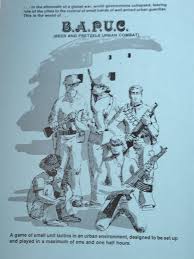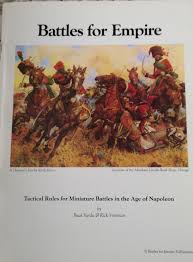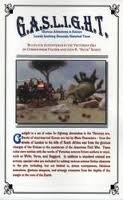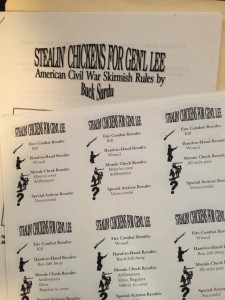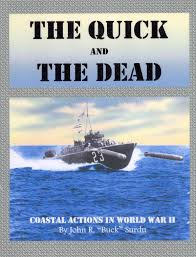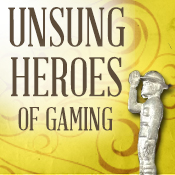
In this fourth post of Unsung Heroes of Gaming, CigarBoxBattle.com gets the great privilege of interviewing Col. John “Buck” Surdu, an incredibly accomplished independent Game Designer. He’s created and contributed to Cigar Box Battle favorites like G.A.S.L.I.G.H.T. We’re going to talk to him about this and more. Welcome Buck in a BIG WAY!
CBB – Are you or have you been a gamer? (Miniature Wargames, Role-Playing Games, or Board Games)
Buck – I began as a board gamer and then branched into both miniatures and role-playing games.
CBB – What kinds of games do you prefer to play?
Buck – I prefer miniatures games, because of the multi-player aspect. If you’re familiar with the Myers-Briggs personality survey, I am an INTJ, and I peg out the “I” meter (“Introvert”). A career in the Army teaches you that the world rewards “E,” or extrovert, behavior. I have learned to pretend that I am an E. For me, the multi-player aspect of miniatures game is my major social outlet.
CBB – What was the first “hobby” game you ever played?
Buck – My first hobby games were Cemetery Hill and Antietam, which were one of the SPI folio games. The folio games were the games that used to come in the Strategy and Tactics magazines or QuadriGame sets. The successful ones were packaged up in a folder (or folio) where the rules, single map sheet, and sheet of counters (usually 100 counters maximum) fit in the two side pockets.
My entry into the hobby began with the confluence of four events. The first was a human-interest piece at the end of the nightly news about Jack Scruby and his club out in California. My dad collected and painted 54mm figures and the old toy soldiers (e.g., Britains) like you see in the hardcover wargaming books from the 60’s and 70’s. He has tens of thousands of them. They look great displayed on a shelf, but he never “played” with them. Jack Scruby and his buddies were playing with their figures! I was smitten by the spectacle of the terrain board covered with figures that were being moved and made to shoot.
The second was a book, called The War Game, edited by Brigadier Peter Young. Young was the most decorated British soldier of WWII and an avid gamer. The War Game was a straight historical book, chronicling ten great battles in history, each written by an expert in that historical period. The fascinating thing about the book is that many of the illustrations were of wargaming figures on the table. The back of the book had an appendix about wargaming as a way to study history and as a hobby.
The third was a birthday gift when I was in seventh grade of the two SPI folio games mentioned earlier. My grandmother found them in a book store and bought them for me for a birthday present thinking they were history books. I pored over the rules and finally cajoled my dad into playing with me. He’s never liked games, particularly wargames, which is funny since he taught history. Over the years, I’ve run across many historians who look down on wargaming. So my dad and I played these games whenever I could talk him into it.
The fourth was the re-release of Little Wars in hard cover. My dad had purchased a copy because of the illustrations of the kinds of figures he collected. In the 70’s, Britains produced a large line of spring-loaded cannons. I had a bunch of the newer, plastic Britains figures with the metal bases as well as a large assortment of the cannons. I bought a piece of wood and cut it into variously sized rectangles to make hills like in the book. I scrounged sticks from the yard, used contact cement to glue on lichen, and stuck them into bases to make trees. The summer between 8th grade and high school was spent on the back patio with anyone I could cajole into playing with me maneuvering my green army men and knocking them down with one-inch bits of dowel shot from spring-loaded cannons.
My dad had a friend who had worked for The Squadron Shop when they had brick and mortar stores in the Detroit area. Eventually, he branched out on his own and opened his own store. On a trip the Walt’s Hobby Shop to pick up paints, my dad brought me with him. The wall of wargames amazed me, including more of the SPI folio games, other SPI titles, and Avalon Hill. My eyes were opened to a new hobby, which would consume my life. It was in Walt’s Hobby shop that I found and bought my first miniatures game (Rally ‘Round the Flag) and first figures (Airfix ACW).
As a high school freshman, I met a girl in Latin class whose brother, Mike, had been a substitute teacher in my middle school. Though a conscientious objector during Vietnam, partly driven I think by his father’s PTSD from his experiences in the 101st during WWII, he was a wargamer. Through his sister, I found that he was a gamer; although, today I can’t remember how the subject ever came up in the middle of conjugating verbs. I also found one or two other folks who were curious enough about what I was talking about that I got them to play Rally ‘Round the Flag with me. We played from time to time in my basement, and the guys enjoyed the gaming. Mike brought us all to Walt’s Hobby Shop from time to time, and convinced us to try this new thing, called Dungeons and Dragons.
As a kid, I read mostly history and some of the classics. My dad had a large selection of Landmark books, which were kid’s history books. I didn’t read fantasy books, so I wasn’t all that interested in wandering around a hole in the ground while fighting goblins and orcs. I didn’t even know what an orc was. TSR had released the first Dungeons & Dragons (D&D) basic set, in a bluish box with a rulebook, sample dungeon, some character sheets, and the polyhedral dice. I bought a copy and we tried it. We really enjoyed it. During one of the trips to Walt’s Hobby Shop, another friend of my dad, Al Slisinger, convinced one of the guys to try Tunnels and Trolls (T&T). To this day, I prefer the systems in T&T over any of the versions of D&D I have played. After trying it out, we all bought copies of T&T and began running games.
Mike brought several of us to our first wargaming convention, WinterCon. At the time, the Metro Detroit Gamers hosted two major shows a year (WinterCon and MichiCon), run by an unsung hero, Mike Bartnikowski. These were multi-genre shows, including role-playing, board games, and miniatures. They also had vendors! I can’t express the excitement of strolling through the vendor area and seeing all the gaming options available. It was at my first WinterCon that I played my first Napoleonic game. While the truth is clouded in childhood memories, what I remember is a Napoleonic game with at least twenty players using rules that I think were Empire II. The three or four of us who got in the game had never played the rules before, but one guy, who I remember as excitable and foul-mouthed (we all went to Catholic school), took us under his wing and helped us with the rules and tactics. “Kid luck” prevailed, and we Prussians smashed the French who were attacking us. One of the things I remember about this game was how there were several adults who were angry that kids were taking slots in a game they wanted to play. It was one of the experiences that have prompted me to try to interest kids into the hobby over the years.
These convention experiences opened my eyes to different types of gaming. We were young and full of energy. We gamed all day in scheduled events and then sat up all night in the Student Union trying new games that one of us had bought.
Our circle of gamers widened over time. From the three or four I rounded up initially, our group grew to eight or nine friends of friends, meeting regularly throughout high school. One of those friends of friends would become one of the few folks from high school I have kept up with over the years, Jim Dziadziola. JJ and I were the main zealots in the group, and we both still game today. For a time we played in one kid’s basement on his dad’s pool table. Many Star Fleet Battles and D&D games were played on that table. My church had once hosted an elementary school, but the school was closed, so the classrooms were only used for religious education. The pastor at our church let us use one of the classrooms on Saturdays to game. I have many fond memories of those Saturdays at St. Timothy’s church gaming with my buddies, everything from role-playing, to board games, to miniatures. Everyone had a favorite system, so we all took turns as game master.
This was my first “golden period” of gaming. All was new and exciting. Every other week it seemed TSR was releasing a new role-playing game, like Boot Hill, Gamma World, and Top Secret. We played a fair amount of Traveller and Tunnels and Trolls. Dungeon crawls were still new and fresh, not passé as they seem today. The TSR, SPI, and Avalon Hill catalogs were huge and growing. I continued to paint more and more Airfix plastic ACW figures and host larger and larger miniatures games. I got my hands on a pre-publication version of a post-apocalyptic role-playing game, called The Morrow Project, which provided hours of fun. About the time I saw the movie Zulu for the first time, I discovered The Sword and the Flame. We continued to attend the local gaming conventions, where we played our first fantasy miniatures games and I got to play Ship of the Line (the miniatures version of Wooden Ships and Iron Men). I even had my first experience meeting a game designer, the guy who wrote the first version of Source of the Nile before it was purchased by Avalon Hill. All was right with the world.
In the late 70’s D&D became widely know, largely due to an erroneous connection with playing in college steam tunnels, derived from the James Dallas Egbert disappearance. The mom of one of my friends was the librarian at one of the local libraries and asked me to host an event at the library to teach people about D&D. It was a pretty successful event, drawing about 30 kids into the library for my lecture and the opportunity to participate in a couple of hours of dungeon crawling.
As a plebe at West Point, I didn’t have an opportunity to do much gaming. Then, I discovered a group of cadets who played Napoleonic miniatures on Saturdays. Things are different now, but in those days we had classes on Saturday mornings, usually followed by a parade. By about 1400 we would finally get some free time. Major Lawson had rounded up a group of cadets and had all the figures we needed to play large Napoleonic games. He introduced us to this new set of rules, Empire III, which we played avidly once or twice a month until he was reassigned my senior year. These were the biggest Napoleonic games I have ever seen, with sometimes 20 players. To that time, my only miniatures had been plastic Airfix ACW, but he got each of us to pick a nation (as a plebe, I got what was left, England) and paint figures. I only pulled two all-nighters at West Point and both were to get a new battalion painted for the next day’s battle! In this group at West Point, I met Dave Wood, who has been a life-long friend and gamer. Dave fronted us the money for my first major published rule set (Battles for Empire) and was a collaborator on the Look, Sarge, No Charts family of rules.
CBB – How did you get into Game Design? Tell us about it?
Buck – I think I was interested in game design almost from the beginning. I designed and published a board game as a senior in high school, selling it through Walt’s Hobby Shop. It was called Beer and Pretzels Urban Combat (BAPUC). It had a multi-color board with parallelogram buildings like the SPI game Sniper, but the board and rules were my own design. A friend of my dad was an art teacher, and he designed the cover art and the art on the counters. Another of his friends had been a designer, and he did the four-color separations for me to print the board. It remains a pretty good game. My friends and I had a lot of fun with the game, even those who were otherwise not gamers. As a junior at West Point, I remember hearing lots of whooping and laughing as I walked down the hall of one of the academic buildings for a Saturday wargame. When I reached the source of the raucous laughter, it was a bunch of guys playing BAPUC. That’s when I become hooked on game design. There’s no money to speak of in this hobby, but when you can see a bunch of folks having a good time playing a game you wrote, that is very rewarding.
Before BAPUC, however, I had had several abortive attempts at game design. I tried to write another modern skirmish game that never amounted to anything. The interesting bit was that I was trying to balance the game by having players control fewer soldiers if the soldiers were of higher quality. A local gamer (an adult) put me on the spot about why my unit sizes were doctrinally correct. I tried to explain my rationale, but not very effectively. This was an important event, because it taught me to do my research and that I needed to make my design decisions explicit and defensible.
Another friend and I attempted to write a role-playing game. We didn’t really have any goals in mind other than a desire to write a role playing game. (By the way, this is a bad way to start a design project!) It was my first opportunity to really experiment with different game mechanics. At a time when all role-playing attributes seemed to have been generated by 3d6, we fiddled with using different polyhedral dice for attribute generation.
After BAPUC, my first real game design project was Battles for Empire. BFE was largely a reaction to having played Empire III for ten years, but it was a ground-up, clean sheet of paper design. Empire III had a lot of positive attributes and was really innovative; however, after ten years, we still couldn’t get through a game without arguments about the rules. I wanted something more streamlined. Your younger readers probably don’t appreciate the fact that in the early days there were a few “standard” sets of rules for different historical periods. We didn’t have the proliferation of titles that we have today. When we launched the BFE design process, we did a few things that I have maintained in all my subsequent projects. The most important one was to sit down over a series of nights and clearly articulate our goals. All subsequent mechanics and design choices then had to be consistent with those goals. Many games on the market seem to mix levels of abstraction and lose sight of what level of command is the focus of the game. Many are merely a heavy modification and repackaging of someone else’s intellectual property. By the way, you can usually find copies of BFE in flea markets and on-line, although it is long out of print. This game had a lot of features that were innovative and fresh when we published it that have become commonplace today. To date it probably still has the best production values of anything I’ve designed; I’ve never come close again to the production quality of BFE. The distributors told us that, as unknown authors, we might sell 300 copies of the rules. Over two years we sold nearly 2000 copies.
After BFE my next game design project, sometimes with a partner and sometimes solo, was a six-year effort to design a good WWII skirmish game. The first attempt had a goal of limited knowledge of firing effects based on my infantry experiences. In this game, which I called Action Front, the shooter rolled to hit the enemy target, but the target rolled for the effect, which could be a suppression, wound, or kill. As the shooter you would know you didn’t see that enemy soldier in the window any more, but you wouldn’t know if he was dead or just suppressed. After about two years of trying to make this system work – and having the entire book written and formatted – I threw it out and started over. The second attempt was even less successful. Eventually I developed Beer and Pretzels Skirmish, which was still being played ten years after publication. It’s an oldie, but a goodie, for a game in which players control one or two squads. There are many interesting mechanics in BAPS, the most unique of which is the method of resolving firepower. I’ll answer this question later, but here is where I think my “sweet spot” is in game design: developing unique mechanics to simulation some aspect of warfare in an elegant way.
CBB – What was your first Game Design commission? Tell us about it?
Buck – I’ve only done one game design by commission. I had written a set of rules with Pete Panzeri, Santa Anna Rules, for the Mexican War. I can’t sell ice water to men in Hell, but Pete knows everyone. He worked a deal with Old Glory to get us lots of figures at a discount if we painted them up and ran games in conventions featuring the figures and mentioning Old Glory as the sponsor. I was living in Texas at the time and had a growing interest in the Mexican War. Santa Anna Rules was really two sets of rules, published separately, the tactical set, for which I was the primary author, and the skirmish set, for which Pete was the primary author. I still think they are a good set of rules with a number of interesting nuances and mechanics, but like most of my stuff, they have been largely overlooked and relegated to flea market sell offs.
In advance of the release of their Vietnam figures, I was approached indirectly by Old Glory about designing a set of rules to accompany the figures. The timeline was very tight, so I didn’t have a lot of time to start from scratch. I had designed and published Beer and Pretzels Skirmish (BAPS) several years earlier. BAPS was designed for a player to command one or two squads and had several interesting mechanics, particularly what I’ve always thought was the best fire resolution procedure of any WWII skirmish game. Old Glory was planning on selling the Vietnam figures in platoon-sized bags, so they wanted a set of rules that had each player commanding something like a bag of troops. I took the basic fire resolution and invented a new and innovative activation mechanism that eliminated a morale phase and allowed a player to command one or more platoons. The result was Fire Team Vietnam. I ran demonstration games featuring the Old Glory figures for a couple of years using the rules. I don’t know if I ever knew how many copies of the book sold, but it must not have been many, because Old Glory never asked me to design anything for them again.
I would like to work with a miniatures company again to release a set of rules at the same time as a new line of figures is released. Today, I’m not sure a solid set of rules is good enough any more. Books have to be filled with superfluous eye candy and have a matching line of figures. I’d still like to do the figures some day, so I won’t reveal the specifics here, but when we were wrapping up The GASLIGHT Compendium, I approached a number of miniatures companies about sets of figures that would lead to cross promotion, but the offer remains open.
CBB – As a Games Designer, what do you feel you are most known for, and which Gaming accomplishment makes you most proud?
Buck – What am I best known for? I’d have to say being a co-author of GASLIGHT. To date it’s the only set of rules I’ve written that have had any real commercial success. We caught the Victorian science fiction wave on the up swing and helped to create that genre for gaming. Implicitly or explicitly, GASLIGHT remains the set of rules that others compare themselves to in the VSF genre. It’s not for everyone, and we have our share of critics. Still, we have a loyal player base and a Yahoo group with over 1000 members.
Of what am I most proud? That is a tough question. I’ve tried to bring something new to each project. I think that each new design has been an improvement in elegance and coherence from the previous one. The production values of Battles for Empire, published in 1988 or so, have only just been replicated in the hobby within the past seven or eight years. GASLIGHT really captures the flavor of the VSF genre. Blood and Swash is a very tight, almost universal skirmish game if you don’t want large numbers of player or morale effects. I think that Rob Dean and I did a nice job with Big Battles for Little Hands, which is a wargaming source book for young kids. It includes a history of land warfare, a primer on tactics, two sets of rules, pointers on painting figures, and even some paper soldiers to cut out and use if the child doesn’t have access to miniatures.
The Quick and the Dead, another virtually unknown title available only as a .pdf download, is really unique and provides a heart-pumping, frenetic gaming experience set in the wild world of e-Boats, MTB’s, and PT Boats. The game engine was based on an unpublished set of rules, called Fire at Will, by Kurt Schlegel. In The Quick and the Dead, there are no turns. Players perform actions asynchronously, as quickly as possible, interrupting the actions of other players. In designing this game, I read every book I could find about coastal actions in World War II. Coastal actions involved three major phases: the stealthy movement to the patrol area, waiting in ambush for enemy shipping, and thirty minutes or so of intense, close-range action. Other sets of rules represent the first two phases well, but The Quick and the Dead was meant to represent just the third, action phase. I think it does that better than any other set on the market.
Having said that, I am most proud of the Look, Sarge, No Charts family of rules. Though largely unknown and under appreciated, the various subsystems are both elegant and coherent; they all work together for a satisfying gaming experience. I wish we had used a different title when we released the first set for World War Two. The use of “sarge” in the title implied to some that it was a skirmish game, when in fact it was at the same scale as Spearhead, Command Decision, and Rapid Fire. The overall title was meant to catch attention because it was humorous, but I think it had a negative effect, by implying the game was silly. The activation mechanism is truly innovative, and some have suggested that I should patent it. The firing mechanisms, spotting, and morale are all unique, and more importantly, they work together in a seamless way.
CBB – What is your favorite part of the Game Design process? Tell us why?
Buck – For me the most interesting part of game design is problem solving. I really enjoy learning about a new historical period, working to distill the key aspects of the period that make it both interesting and different from other periods, and then working though the process of representing those salient aspects in a streamlined and elegant way.
The other game designers with whom I’ve spent the most time talking are Rich Hassenauer (Fire and Fury, Regimental Fire and Fury, and Battleground) and Scott Fisher (Arc of Fire and Check Your Six!) Though we all approach design differently, they both echo my enthusiasm for working through the analysis and design of game mechanics. For instance, where I strive for the absolute minimum mechanics necessary to capture a period, Rich works to make his charts use period-specific nomenclature to give the games authentic flavor. All three of us work hard to get our designs right and each of use has taken three or more years to realize a new game.
I’ve been working on some new ideas for World War II skirmish. I’ve been posting a series of articles on my blog at various steps of the process. The only reader of my blog recently commented that watching my thinking evolve during the design process has been “interesting.” Like my other projects, I began be writing a list of what I want to accomplish. For this game, I want to be able to represent both “straight historical” skirmishing as wells as more “cinematic” games.
For modern skirmish actions, I really try to restrict the amount of control the players have over the rate and distribution of fire of their figures. A natural consequence of this desire is that I don’t want players to be able to choose their targets. We’ve all been in these games where the enemy is able to pick off the leaders and key weapons with little effort. BAPS had a unique way of doing this. I spent almost a year working through several ideas while running. I even subjected a couple of my buddies to one attempt a few months ago. It actually worked well enough for a two-player game, but I was convinced that it wouldn’t scale to multi-player or convention games and so went back to the drawing board. I subjected six players to the current incarnation a few weeks ago and think I’m on the right track this time.
CBB – Which part of the Game Design process, do you feel, is your “sweet spot” or specialty? Tell us why?
Buck –
I think what I bring to the table is an ability to tease out the essential aspects of a period and distill them into simple, elegant mechanics that provide a unique and entertaining gaming experience. I really enjoy taking weeks to mull through lots of options for how best to represent something.
I recently overheard a buddy talking to someone at a convention about my games. He made the comment that many of my mechanics are unusual and need explanation but once they are explained to you they make sense and work well. As an example, in modern skirmish rules, typically you make a dice roll (or more) for each firing soldier. In my mind, the problem with this approach is that it allows the player unrealistically accurate control of rated and distribution of fire. In GASLIGHT we dealt with this by rolling the total number of hits and then randomizing which figures are hit. This adds a randomizing step to the firing process. In Beer and Pretzels Skirmish I took a different approach that achieves an even better result without additional die rolls. The player adds the total amount of firepower going into a target area and then rolls once per target soldier, rather than once per firing soldier. This seems counter intuitive to many gamers, because I am the only person who does it this way, but it achieves the randomizing effect I wanted without any additional steps or die rolls in the firing process.
The new set of rules I am developing take a hybrid approach. The firing player flips one card for each shot. If the shot is a hit, the player flips a second card that simultaneously randomizes which soldier was hit, where that soldier was hit, and whether that area is protected by cover. The jury is still out on whether this system will speed play in the way I desire while retaining the unpredictability of which target was hit.
CBB – Have you worked on any recent projects you would like to tell us about?
Buck – I’m currently working on two projects at the same time. The next incarnation of the Look, Sarge, No Charts family is Bear Yourselves Valiantly for ancient, mediaeval, and fantasy games. This is another collaboration with Chris Palmer and Dave Wood and this time includes James “Tank” Nickle. We’ve been doing quite a bit of play testing and we think that we’re just about done with development and can begin working on the rule book. (Once development is done, it takes about six months to write the book, shoot the photos, do all the layouts, and prepare for printing.)
Adapting the Look, Sarge, No Charts system to this period has been interesting. We needed to drastically reduce the flexibility and mobility of the units compared to the other periods. I think we’ve achieved a nice balance between reflecting the capabilities of ancient units while remaining a fun game. In fact we’ve had players say it was the first time they’ve ever enjoyed an ancient game. Bear Yourselves Valiantly is not intended for tournaments, and it is not meant to allow anachronistic matchups of armies from different historical periods.
While not intended for the tournament crowd, because fantasy armies are so varied, we created a point system. This is not meant to be bullet proof; rather, it is designed to help a GM balance a scenario. I’ve even built a nice spreadsheet that lets players fiddle with the attributes of their units and automatically calculate the point value of the force. We’ve made a few adjustments over the past year and a half, but the point system seems to be about right.
Tank has been running Roman vs. Carthaginian games at the HMGS East shows. Chris and I have been running fantasy. We’ve recently play tested a couple of games with Hundred Years Wars era armies. I’m thinking about Arthurian armies, but I’m not sure which Arthurian armies to create.
While we have been working on this set of rules as a team, I’ve also been fiddling with some interesting ideas for a card-based WWII skirmish game. Cory Ring of Cigarboxbattle.com may remember “Stealin’ Chickens for Gen. Lee”. In those rules the cards for the game were divided into three regions: fire, melee, and morale. When you drew a card you read the result in the appropriate region of the card, depending on what action you were taking. This new set of rules takes a similar approach.
Each figure has the following attributes: Guts, Accuracy, Melee, Endurance, and Reaction. These rules will be called GAMER. By adjusting these values, the game can be more “realistic” or “cinematic.” Your readers can see how these rules are evolving by searching through my blog (www.bucksurdu.com/blog) for “world war II.” Early play tests have been positive, but I’m not happy with it yet. I figure it’s about a year away from public unveiling at a convention.
CBB – What will you be working on next?
Buck – I always try to have an idea for my next project. Often another idea pops up and I move a project to the back burner or from the back burner to the front burner. That’s what happened with GAMER. I had planned for that to be the project after next, but ideas began popping into my head, and it began to get excited about it again.
The next project in the pipeline, however, is another in the Look, Sarge, No Charts family of rules. I don’t have a working title yet, but it will be a set of rules for near future science fiction ground battles. I want this to be more than World War II with lasers. I really want to bring something new to this genre. I have been jotting down ideas for unique ways to handle drones, smart weapons, and remote sensors. In addition, I want to have an explicit phase between turns dedicated to cyber warfare. Players will employ their cyber forces to gain control of enemy networks, disrupt their command and control, take over their sensors and drones, etc. It will also enable an interesting pairing of asymmetric forces.
I have been collecting some interesting ideas for morale and firefights that are in search of the appropriate historical period. I’ve been wanting to begin gaming the American Revolution, and that may well be the testing ground for some of these ideas. As an example, I’ve read that in the horse and musket period, units would often halt and fire rather than close and once they began to fire it was difficult to get them to move again. I’ve been thinking about a mechanism that would require a unit to make a reaction check when it gets near the enemy. One of several possible results will be “halt and fire.” Once this happens, the target unit may experience some disruption but will also make a reaction check, which could include withdraw, charge, or return fire. In this way, I can imagine a general firefight developing despite the wishes of either commander. I’m not sure how this will eventually work out or whether it’s appropriate for the American Revolution, but I like to mull over these kinds of ideas while running in the mornings.
Finally, I think that there is a crying need for a US gaming magazine. I don’t know anything about producing a monthly magazine, but I have some ideas for regular columns, layout, format, on-line augmentation, etc. I am hoping to have time to look into this in earnest some day. I always thought The Courier had much better content than any of the UK magazines but suffered from erratic delivery and inferior eye candy and production values. A US-based gaming magazine could finally give equal time to rules and figures from the US. A US-based gaming magazine cannot be done as a hobby. It must be run like a business, paying for contributions, enforcing a regular publication schedule, selecting engaging theme years, and perhaps including short sets of rules from time to time. I’d love to see a regular column on terrain building and a column targeted at younger kids and those on a budget.
CBB – Have you ever worked on a game that you really wished had been made, but didn’t get produced? Tell us about it.
Buck – I’ve had a number of games I would have liked to publish differently, but none that didn’t get published at all. For instance, since I own a comb binding machine, for Beer and Pretzels Skirmish, I self published for many years and sold from the convention table. (Gamers seem to think that the comb binding looks cheap, but in fact it costs more than stapling the book in the middle, and it has the added benefit of easily laying flat on the gaming table.) I had an idea that I could save the gamers money by having three holes drilled into the loose pages of the book and then anyone who purchased the book could place it into their own view binder. In my mind this created a book you could lay flat, you could add any supplements (there never were any) or your own notes to the binder, and cost less than binding the book in a way that some would like and others would not. Since I’ve never seen anyone copy this idea, I guess it wasn’t a very good one.
When I wrote The Quick and the Dead, I couldn’t get anyone interested in publishing the game. Cards are expensive. Coastal actions in World War II are definitely a small niche period to game. I estimated that I would sell fewer than 100 sets of the game, so we were not going to get to any good break points on volume of printing cards. I had been talking to two miniatures companies. The smaller one makes PT boats in resin, but as a garage operation they didn’t have the wherewithal to take this kind of risk. The larger one was interested, but then the owner suffered a personal tragedy, and the conversation stalled. PT boats were a diversion from getting The GASLIGHT Compendium finished, so I wanted to get this off my plate. I decided to make the game available from RPGNow as a .pdf download. I truncated scenario development time and completed the card design and rules layout work. Because of the .pdf only format and a complete lack of marketing, the rules haven’t done as well as they should.
About ten years ago, I began adapting Canvas Eagles for computer-assisted play. Canvas Eagles is the miniatures version of Blue Max. The idea was to use hand-held devices (Palm Pilots at the time) to provide the interface for players to input their orders, which would be transmitted to a PC. The hand-held devices would then present options to the players for firing, resolve all shots, and report damage to the player controlling the target aircraft. This would provide limited intelligence, because you would only know what damage you had inflicted if the results were obvious, such as a fire. It was an idea ahead of its time, because the technology wasn’t quite ready yet. Today it would be more feasible, but with games like Wings of Glory and X-Wing on the market, there’s little appetite for another simple airplane game. I’ve thought about resurrecting this idea and perhaps applying it to naval gaming, since everyone seems to have a smart phone or Wi-Fi-enabled tablet, but I haven’t found the right collaborator or the time to pursue this.
Buck, we here at CigarBoxBattle.com are incredibly thankful for the opportunity to bring this interview to our readers. We appreciate your kindness and insight. We always look forward to your next gaming project! As a side note: Buck and the Hawks will be at Nashcon 2014 in May (Memorial Day Weekend) this year, so if you are in the area make sure to come by and play in one of Buck’s games!
Readers, if you enjoyed this interview and don’t want to miss any of the upcoming interviews in the Unsung Heroes of Gaming series, all you have to do is click on the “SUBSCRIBE” link at the top of the left sidebar and sign up for email updates for new posts. When you do, you’ll receive notice every time we post new content, PLUS you’ll get all of our freebies we send out!
If you like this interview, also read Rick Preistley’s interview by clicking here
You can always follow us on Twitter plus check out all of our cool gaming boards on Pinterest (LOTS OF EYE-CANDY!)


